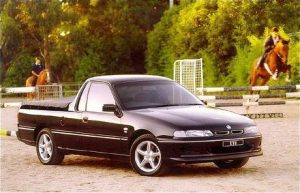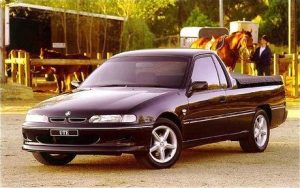Recalls: Holden VS Ute
Overview
Manufacturers, or importers, issue recalls for defects or faults which have the potential to cause injury. Generally, manufacturers will inform the original buyers if their vehicle is subject to a recall and of the steps required to remedy the defect or fault. Please note that the recalls below (if any) are for Australian-delivered vehicles only. Furthermore, the number of recalls should not be taken as an indication of a model’s reliability or its safety more generally.
Recalls: Holden VS Ute
- In July 1995, a recall was issued for Holden VS Ute vehicles manufactured on 10, 11 and 18 April 1995 and with serial numbers in the range 812212 to 815124. For these vehicles, the front suspension strut to knuckle attaching bolts could break and required replacement (PRA 1995/2497).
- In January 1996, a recall was issued for Holden VS Ute models with automatic transmissions and serial numbers in the range L772126 to L895407. In these vehicles, the automatic transmission cooler hose clamp may not provide sufficient clamping – this could cause the hose to creep and, in extreme cases, dislodge from its fitting (PRA 1996/2701).
- In November 1996, a recall was issued for Holden VS Ute vehicles manufactured up to October 1996, fitted with automatic transmissions and tow bars (PRA 1996/2990). For these vehicles, automatic transmission fluid could leak from the transmission breather and/or dipstick – this fluid could then overheat when towing and potentially ignite if it contacted hot engine components. The affected vehicles had the following VIN numbers –
- For vehicles with V6 engines: L645621 to L979936; and,
- For vehicles with V8 engines: L645621 to L986809.
- In July 1997, a recall was issued for Holden VS Series II (VS.II) vehicles manufactured from 30 June 1997 to 16 July 1997 due to steering gears having potentially been assembled with an incorrectly hardened rack bar. The incorrectly hardened bar could fracture, resulting in a reduction of steering control (PRA 1997/3239).
- In November 2000, a recall was issued for VS Series III (VS.III) vehicles fitted with 5.0-litre V8 engines (code LB9), the XT9 emission upgrade option and manufactured post-November 1998. For these vehicles, the fuel feed hose may not have been manufactured to the correct specification – this could cause the hose to suffer thermal degradation, causing a fuel leak and potential fire hazard (PRA 2000/4550).
Problems and faults: Holden VS Ute
Overview
This section identifies potential problems, causes and fixes based on the experiences of owners and repairers, online sources and technical service bulletins. This information is provided solely for reference purposes and AustralianCar.Reviews recommends that only properly qualified persons carry out repairs or modifications. Furthermore, the number of items below should not be taken as an indicator of a model’s reliability or the frequency with which they may occur.
To report a problem or fault to the AustralianCar.Reviews team, please use the Contact Us form. Note that AustralianCar.Reviews does not offer advice on automotive problems or disputes; such enquiries will not receive a reply. For vehicles purchased from dealers after 1 January 2011, please see our Australian Consumer Law fact sheet.
V6 Engines
- Fatigue of the tensioning spring in the engine belt assembly may cause loud rattling noises, usually at low revs. The tensioning spring cannot be replaced by itself – the tensioner bracket must be replaced simultaneously.
- The timing chain connecting the crankshaft and the camshaft may stretch over time and become noisy, usually when accelerating (i.e. when under load).
- The engine serpentine belt pulleys may wear and become noisy – these are a common replacement item.
- The rear main seal may deteriorate over time, resulting in oil leaking from the back of the crankshaft – replacement may require the transmission to be removed for access.
- A loud rattling noise from the engine bay may be due to the counter weight on the inner hemisphere of the harmonic balancer contacting the outer hemisphere.
- Coolant may leak from the water pump, causing the internal seal of the water pump to fail. If the coolant is not used or maintained, the front timing cover of the engine can corrode and leak.
- A light knocking or tapping noise at idle may be due to pulses in the fuel line being transferred to the body – fuel line hammer kits were released to fix this problem.
- For supercharged engines, the belt may squeal or chirp during cold starts if the supercharger belt is old or the pulleys are misaligned.
V8 Engines
- The rear main seal is susceptible to leaking and replacement requires the engine, and then the crank, to be removed. In mid-1997, pre-formed synthetic rear main seals with steel inserts were incorporated into production.
- After a cold start, V8 engines may experience oil circulation problems and low oil pressure – this may be due to the oil pick-up strainer becoming clogged with carbon deposits in the oil system. Servicing and oil cleaners can reduce carbon build-up, but extreme cases may require the sump and pick-up strainer to be removed and cleaned.
Transmissions
- Automatic transmissions:
- The lock-up torque converter – which acts like an overdrive gear – can distort due to heat or excessive strain and cause driveline vibrations from 1500-1800rpm.
- The Allen head bolts which secure the gearbox rubber mount to the transmission can become loose, allowing the transmission to move independently of the mount – this can cause driveline vibrations during acceleration.
- Manual transmissions:
- Manual transmissions could transfer gear noise to the gear lever – revised gear levers, with softer dampeners, were subsequently released.
- The clutch fluid reservoir cap was susceptible to cracking (where it attached to the threaded section of the cap) – a revised cap was introduced in mid-2000.
Electrical
- The crank angle sensor is susceptible to internal cracking and may result in the engine failing to start when warm. Dousing the sensor – located behind the harmonic balancer – may cool the sensor, cause it to contract and temporarily restore connections.
- Excessive current flow can cause the alternator to fail and damage the positive alternator cable that connects to the battery – the wiring was revised in mid-1998.
- Problems starting may be due to the bakelite insulator within the starter motor solenoid becoming loose. If starting problems persist after the solenoid is replaced, the battery harness may also require replacement if it is drawing excessive current.
- Oxygen sensors are susceptible to failure, causing erratic engine idle and performance.
- Faulty electrical components may be due to the body control module failing – replacement will require a new alarm remote.
Problems and faults: Holden VS Ute
- Each air conditioning fan speed relied on an individual resistor, located in the air conditioning box; when a resistor broke, that fan speed would stop working.
- Cruise control stalks are prone to failure due to worn button contacts or broken wires at the end of the stalk.
- A knocking sound from the steering rack may be due to a worn left-side inner shaft bush.
- Windscreen wiper arm mechanisms can break at the right mounting bracket below the front windscreen – this can result in the wiper arm hitting and cracking the front windscreen.
- When the double pivot bonnet hinges wear out, the rear corners of the bonnet can touch against the windscreen when the bonnet is opened – this contact can chip the windscreen.




